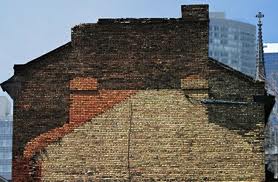 |
| Archimedes Palimpsest, Middle Ages |
'So what is a palimpsest?' you might ask. The image above of Archimedes' Palimpsest is a great example of this historical phenomenon. Before paper became the ubiquitous (and disposable) writing surface that it is today, communications were scribed onto palettes of stone, wood, wax and eventually vellum. These palettes or tablets would then be delivered by hand from one (usually wealthy) person to another. When a person wished to correspond and write back - the tablet would be scraped down to reveal a relatively fresh writing surface. Here's where the tablet gets interesting though... often residue of previous texts remained on the surface. Over time, those residues would become deeper and more entangled, forcing scribes to switch directions of writing to maintain as much clarity as possible.
The notion of a palimpsest as it applies to architecture refers to the phenomenon when older structures are either torn down or they are in a state of decay and a ghost or shadow of a previous building informs the present facade of what remains. This can happen in horizontal archeological layers through time (think of a core sample of blueprints on one site) and this can also happen vertically when one building is torn away from the facade of another, as seen below.
If you are interested in seeing more examples of what can be considered architectural palimpsests, I found a fantastic flickr group that is open to the public (meaning you can view photos and contribute your own photos as well) which you can access by clicking the link above. For me, the exciting thing about the palimpsest is that it is a historical reveal, a kind of pulling back of the time curtain, allowing a sense of transparency to what we hold as very permanent - the buildings, bricks and mortar we occupy. While the image below is fairly abstract, it is fascinating to realize that each band of texture or colour could be an entire floor from a large building!
 |
| stvk5: flickr contributor |
How does this architectural designation relate to our beloved Gatekeeper's Lodge? Well there are two incidences of architectural palimpsest on the Lodge grounds that I'm excited to share with you. The idea of the Lodge holding a deep history is not new, and I've had several visitors ask me if there are ghosts in the building... suffice to say, there have been times where I'm working by myself, and yet I don't feel alone!
 |
| North facing wall of Lodge |
This appears to be a VERY normal door, placed in a flagstone wall, with average stone steps. The reality of this door is that it goes no where. When standing on the inside of the lodge, this same wall is entirely smooth drywall with no indication of what lies on the exterior of the Lodge. This door brings to mind fantastic tales like The Lion, the Witch and the Wardrobe where a simple door operates as a portal to other places, times and worlds. While I assume that the door was an entryway to the Lodge prior to its structural extension in 1950, when stone was taken from Cambridge Battery to build an addition, I find the choice to keep the door, rather than block in the doorframe very mysterious.
 |
| South facing Lodge lawn |
At the South Lodge lawn, where the flagpole resides, there sits a set of two lovely, lonely stone steps. The lawn does indeed slope gently upwards to the flagpole landing, but the steps to me are a remainder from something structural that once existed on the site. Thomas Fripps was superintendent to the lodge from 1930 to 1959. During his tenure, the lawn pictured above was used as a tree nursery where a significant gardener's shed was also located.
Fripps lived with his wife and daughter not only in the Lodge, but also in Point Pleasant Battery in 1919 after returning from overseas service during World War 1, and then he and his family also lived in Fort Ogilvie. Had these stone steps not remained, I'm not sure if Thomas Fripps' history and relationship with the park would have revealed itself through my research. And whether the steps are just plain old stone steps, or a gateway to broader imaginings of the park and its history - I like these ghosts and they are welcome to join me at the Gatekeeper's Lodge anytime.




No comments:
Post a Comment